2007 SATURN SKY tow
[x] Cancel search: towPage 301 of 384

Each new wheel should have the same
load-carrying capacity, diameter, width, offset and
be mounted the same way as the one it replaces.
{CAUTION:
Using the wrong replacement wheels,
wheel bolts, or wheel nuts on your vehicle
can be dangerous. It could affect the
braking and handling of your vehicle,
make your tires lose air and make you
lose control. You could have a collision
in which you or others could be injured.
Always use the correct wheel, wheel bolts,
and wheel nuts for replacement.
If you need to replace any of your wheels, wheel
bolts, or wheel nuts, replace them only with
new Saturn original equipment parts. This way,
you will be sure to have the right wheel, wheel
bolts, and wheel nuts for your vehicle.Notice:The wrong wheel can also cause
problems with bearing life, brake cooling,
speedometer or odometer calibration,
headlamp aim, bumper height, vehicle ground
clearance, and tire clearance to the body
and chassis.{CAUTION:
Rust or dirt on a wheel, or on the parts to
which it is fastened, can make wheel nuts
become loose after a time. The wheel
could come off and cause a crash. When
you change a wheel, remove any rust or
dirt from places where the wheel attaches
to the vehicle. In an emergency, you can
use a cloth or a paper towel to do this;
but be sure to use a scraper or wire brush
later, if you need to, to get all the rust or
dirt off.
301
ProCarManuals.com
Page 303 of 384

Tire Chains
{CAUTION:
Do not use tire chains. There is not
enough clearance. Tire chains used on
a vehicle without the proper amount of
clearance can cause damage to the
brakes, suspension, or other vehicle
parts. The area damaged by the tire
chains could cause you to lose control of
your vehicle and you or others may be
injured in a crash. Use another type of
traction device only if its manufacturer
recommends it for use on your vehicle
and tire size combination and road
conditions. Follow that manufacturer’s
instructions. To help avoid damage to
your vehicle, drive slowly, re-adjust or
remove the device if it is contacting your
vehicle, and do not spin your wheels.
If you do �nd traction devices that will �t,
install them on the rear tires.
If a Tire Goes Flat
Your vehicle has a tire in�ator kit. There is no
spare tire, no tire changing equipment, and
no place to store a tire.
It is unusual for a tire to blow out while you are
driving, especially if you maintain your tires
properly. SeeTires on page 284. If air goes out
of a tire, it is much more likely to leak out slowly.
But, if you should ever have a blow out, here are
a few tips about what to expect and what to do:
If a front tire fails, the �at tire will create a drag
that pulls the vehicle toward that side. Take
your foot off the accelerator pedal and grip the
steering wheel �rmly. Steer to maintain lane
position, and then gently brake to a stop well out
of the traffic lane.
A rear blow out, particularly on a curve, acts much
like a skid and may require the same correction
you would use in a skid. In any rear blow out,
remove your foot from the accelerator pedal.
303
ProCarManuals.com
Page 309 of 384

7. Push the in�ator kit switch to the I (on)
position.
The in�ator kit will force sealant and air into
the tire. Sealant may leak from the puncture
hole until the vehicle is driven and the hole
has sealed.
8. Make sure there is a proper connection
between the tire valve stem and the
sealant �lling hose by looking at the air
pressure gage. If there is not a pressure
reading while the compressor is running,
the connection between the in�ator kit and
the tire is bad.
Check the attachment between the sealant
�lling hose and the tire valve stem.
9. In�ate the tire up to the recommended
in�ation pressure, found on the Tire and
Loading Information label located on
the vehicle’s center pillar (B-pillar) below the
vehicle’s door latch, using the air pressure
gage on the top of the unit.
The pressure gage reading is slightly high
while the compressor is on. Turn the
compressor off to get an accurate pressure
reading.Notice:If the recommended pressure cannot
be reached after 15 minutes, the vehicle
should not be driven farther. Damage to the
tire is severe and the sealant will not be
effective. Remove the air compressor plug
from the accessory power outlet and unscrew
the in�ating hose from the tire valve. See
Roadside Assistance Program on page 359.
10. Push the in�ator kit switch to the O (off)
position once the correct tire pressure is
obtained.
11. Turn off the engine.
12. Unplug the air compressor accessory plug
from the accessory power outlet in the
vehicle.
13. Disconnect the sealant �lling hose from the
tire valve stem, by turning it counterclockwise,
and replace the tire valve stem cap.
Be careful when handling the tire in�ator
components as they may be hot after usage.
14. Wrap the sealant �lling hose around the air
compressor channel to stow it in its original
location.
309
ProCarManuals.com
Page 310 of 384
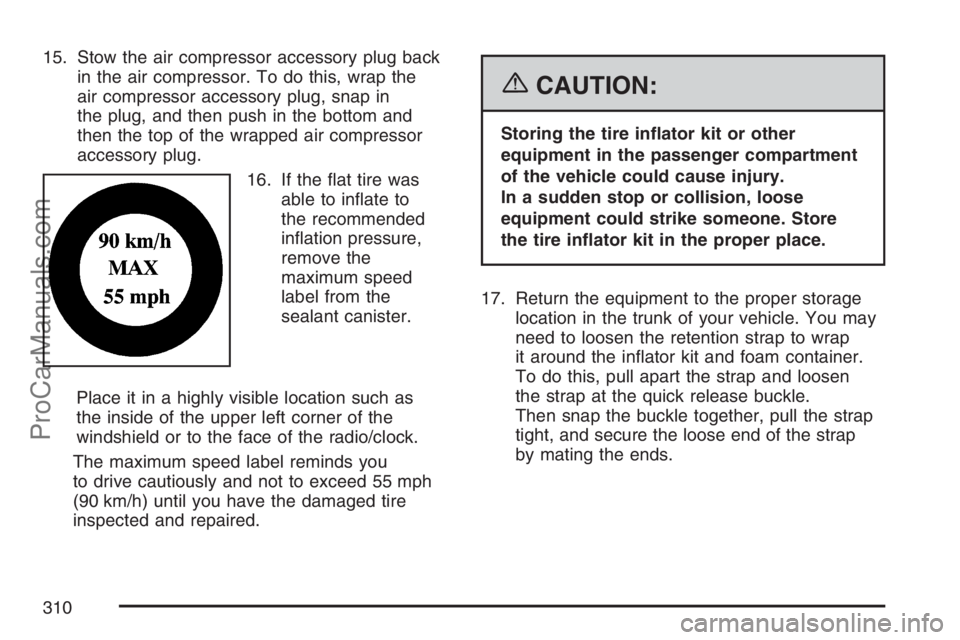
15. Stow the air compressor accessory plug back
in the air compressor. To do this, wrap the
air compressor accessory plug, snap in
the plug, and then push in the bottom and
then the top of the wrapped air compressor
accessory plug.
16. If the �at tire was
able to in�ate to
the recommended
in�ation pressure,
remove the
maximum speed
label from the
sealant canister.
Place it in a highly visible location such as
the inside of the upper left corner of the
windshield or to the face of the radio/clock.
The maximum speed label reminds you
to drive cautiously and not to exceed 55 mph
(90 km/h) until you have the damaged tire
inspected and repaired.
{CAUTION:
Storing the tire in�ator kit or other
equipment in the passenger compartment
of the vehicle could cause injury.
In a sudden stop or collision, loose
equipment could strike someone. Store
the tire in�ator kit in the proper place.
17. Return the equipment to the proper storage
location in the trunk of your vehicle. You may
need to loosen the retention strap to wrap
it around the in�ator kit and foam container.
To do this, pull apart the strap and loosen
the strap at the quick release buckle.
Then snap the buckle together, pull the strap
tight, and secure the loose end of the strap
by mating the ends.
310
ProCarManuals.com
Page 314 of 384
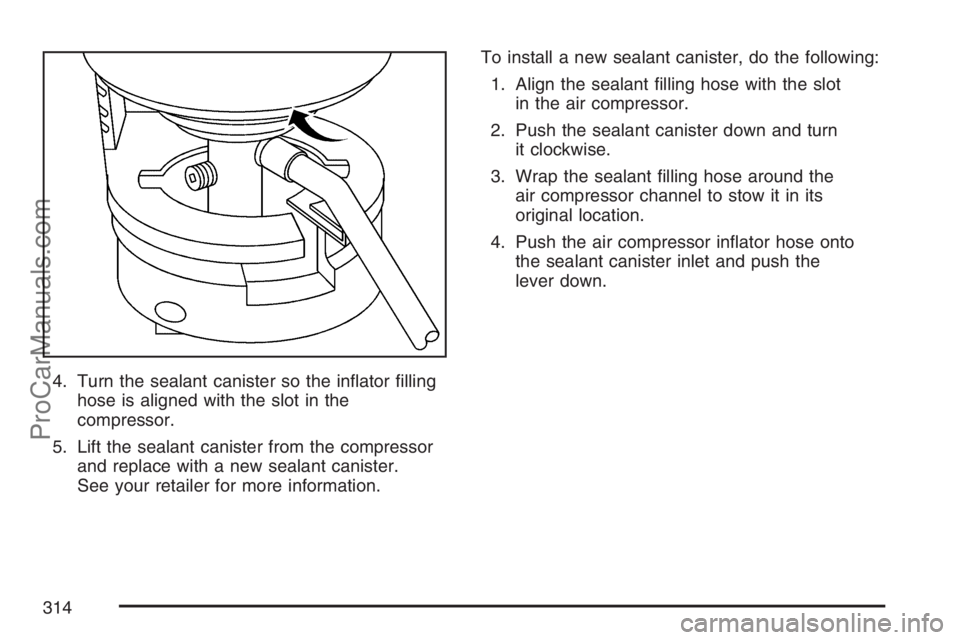
4. Turn the sealant canister so the in�ator �lling
hose is aligned with the slot in the
compressor.
5. Lift the sealant canister from the compressor
and replace with a new sealant canister.
See your retailer for more information.To install a new sealant canister, do the following:
1. Align the sealant �lling hose with the slot
in the air compressor.
2. Push the sealant canister down and turn
it clockwise.
3. Wrap the sealant �lling hose around the
air compressor channel to stow it in its
original location.
4. Push the air compressor in�ator hose onto
the sealant canister inlet and push the
lever down.
314
ProCarManuals.com
Page 316 of 384
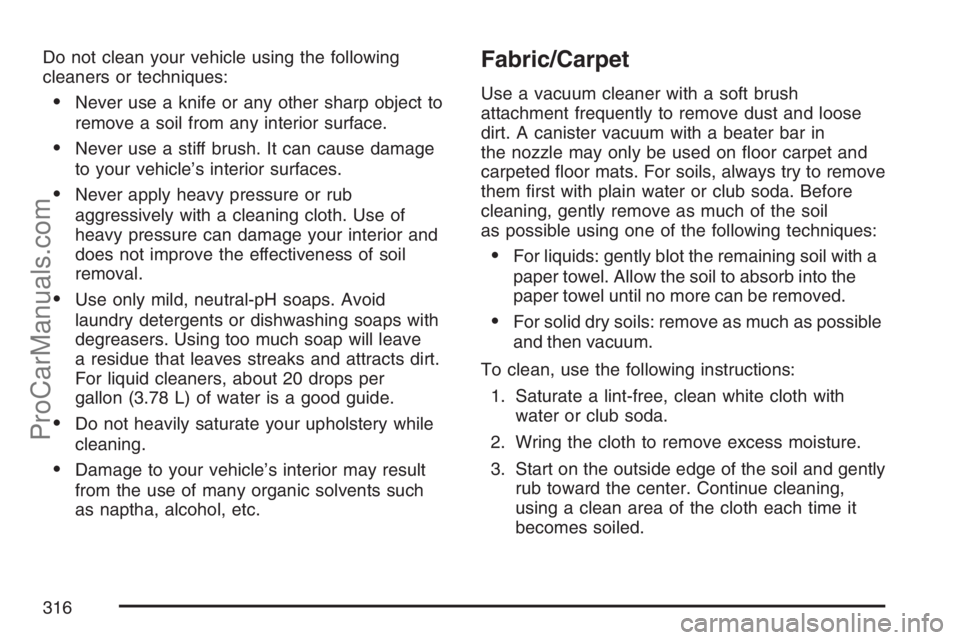
Do not clean your vehicle using the following
cleaners or techniques:
Never use a knife or any other sharp object to
remove a soil from any interior surface.
Never use a stiff brush. It can cause damage
to your vehicle’s interior surfaces.
Never apply heavy pressure or rub
aggressively with a cleaning cloth. Use of
heavy pressure can damage your interior and
does not improve the effectiveness of soil
removal.
Use only mild, neutral-pH soaps. Avoid
laundry detergents or dishwashing soaps with
degreasers. Using too much soap will leave
a residue that leaves streaks and attracts dirt.
For liquid cleaners, about 20 drops per
gallon (3.78 L) of water is a good guide.
Do not heavily saturate your upholstery while
cleaning.
Damage to your vehicle’s interior may result
from the use of many organic solvents such
as naptha, alcohol, etc.
Fabric/Carpet
Use a vacuum cleaner with a soft brush
attachment frequently to remove dust and loose
dirt. A canister vacuum with a beater bar in
the nozzle may only be used on �oor carpet and
carpeted �oor mats. For soils, always try to remove
them �rst with plain water or club soda. Before
cleaning, gently remove as much of the soil
as possible using one of the following techniques:
For liquids: gently blot the remaining soil with a
paper towel. Allow the soil to absorb into the
paper towel until no more can be removed.
For solid dry soils: remove as much as possible
and then vacuum.
To clean, use the following instructions:
1. Saturate a lint-free, clean white cloth with
water or club soda.
2. Wring the cloth to remove excess moisture.
3. Start on the outside edge of the soil and gently
rub toward the center. Continue cleaning,
using a clean area of the cloth each time it
becomes soiled.
316
ProCarManuals.com
Page 317 of 384
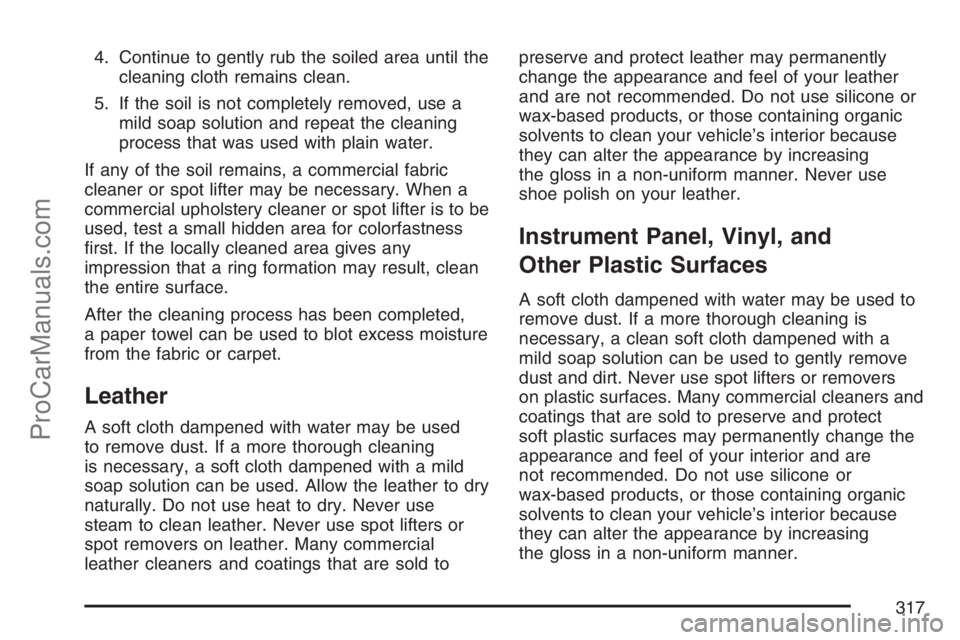
4. Continue to gently rub the soiled area until the
cleaning cloth remains clean.
5. If the soil is not completely removed, use a
mild soap solution and repeat the cleaning
process that was used with plain water.
If any of the soil remains, a commercial fabric
cleaner or spot lifter may be necessary. When a
commercial upholstery cleaner or spot lifter is to be
used, test a small hidden area for colorfastness
�rst. If the locally cleaned area gives any
impression that a ring formation may result, clean
the entire surface.
After the cleaning process has been completed,
a paper towel can be used to blot excess moisture
from the fabric or carpet.
Leather
A soft cloth dampened with water may be used
to remove dust. If a more thorough cleaning
is necessary, a soft cloth dampened with a mild
soap solution can be used. Allow the leather to dry
naturally. Do not use heat to dry. Never use
steam to clean leather. Never use spot lifters or
spot removers on leather. Many commercial
leather cleaners and coatings that are sold topreserve and protect leather may permanently
change the appearance and feel of your leather
and are not recommended. Do not use silicone or
wax-based products, or those containing organic
solvents to clean your vehicle’s interior because
they can alter the appearance by increasing
the gloss in a non-uniform manner. Never use
shoe polish on your leather.
Instrument Panel, Vinyl, and
Other Plastic Surfaces
A soft cloth dampened with water may be used to
remove dust. If a more thorough cleaning is
necessary, a clean soft cloth dampened with a
mild soap solution can be used to gently remove
dust and dirt. Never use spot lifters or removers
on plastic surfaces. Many commercial cleaners and
coatings that are sold to preserve and protect
soft plastic surfaces may permanently change the
appearance and feel of your interior and are
not recommended. Do not use silicone or
wax-based products, or those containing organic
solvents to clean your vehicle’s interior because
they can alter the appearance by increasing
the gloss in a non-uniform manner.
317
ProCarManuals.com
Page 318 of 384
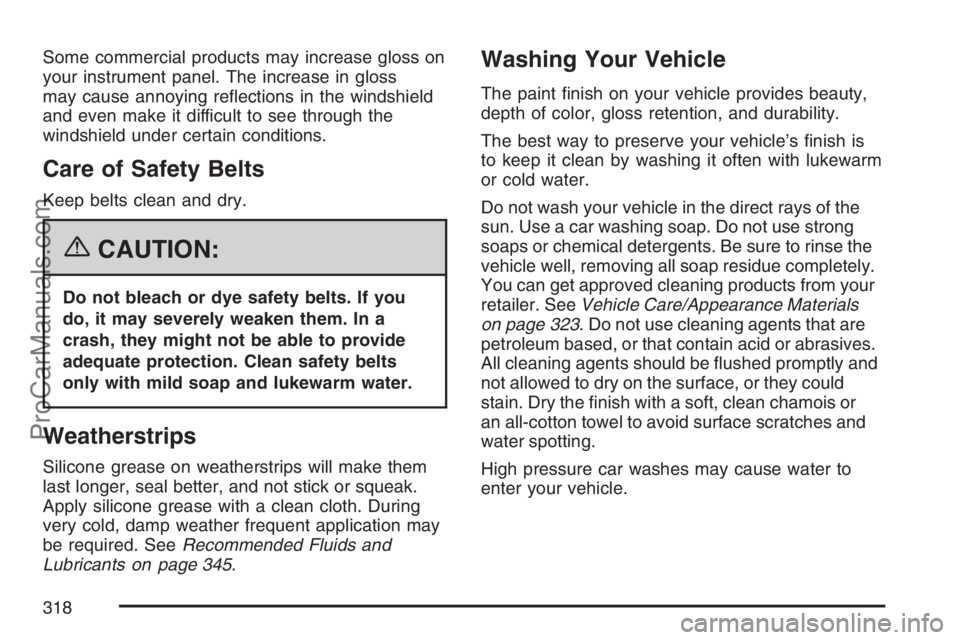
Some commercial products may increase gloss on
your instrument panel. The increase in gloss
may cause annoying re�ections in the windshield
and even make it difficult to see through the
windshield under certain conditions.
Care of Safety Belts
Keep belts clean and dry.
{CAUTION:
Do not bleach or dye safety belts. If you
do, it may severely weaken them. In a
crash, they might not be able to provide
adequate protection. Clean safety belts
only with mild soap and lukewarm water.
Weatherstrips
Silicone grease on weatherstrips will make them
last longer, seal better, and not stick or squeak.
Apply silicone grease with a clean cloth. During
very cold, damp weather frequent application may
be required. SeeRecommended Fluids and
Lubricants on page 345.
Washing Your Vehicle
The paint �nish on your vehicle provides beauty,
depth of color, gloss retention, and durability.
The best way to preserve your vehicle’s �nish is
to keep it clean by washing it often with lukewarm
or cold water.
Do not wash your vehicle in the direct rays of the
sun. Use a car washing soap. Do not use strong
soaps or chemical detergents. Be sure to rinse the
vehicle well, removing all soap residue completely.
You can get approved cleaning products from your
retailer. SeeVehicle Care/Appearance Materials
on page 323. Do not use cleaning agents that are
petroleum based, or that contain acid or abrasives.
All cleaning agents should be �ushed promptly and
not allowed to dry on the surface, or they could
stain. Dry the �nish with a soft, clean chamois or
an all-cotton towel to avoid surface scratches and
water spotting.
High pressure car washes may cause water to
enter your vehicle.
318
ProCarManuals.com